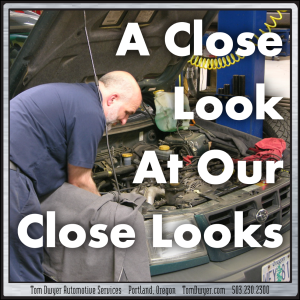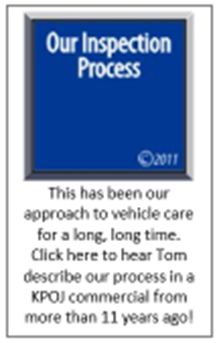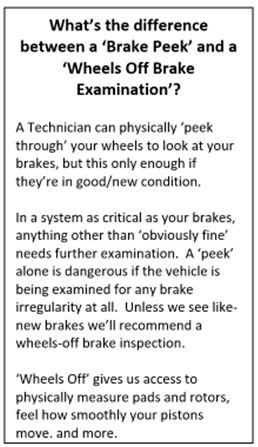 A Close Look at Our Close Looks
A Close Look at Our Close Looks
How we know what’s wrong with your vehicle
Should you trust another shops’ “Free Brake Inspection”? Is our own 90-Point Inspection worth your time? Is our Comprehensive Inspection worth the money? What problems need special, often expensive, diagnosis? Sometimes a vehicle’s problem is obvious but usually solutions aren’t as easy as a ‘quick peek’ or ‘pulling the codes’. Knowing what’s about to go wrong is even harder!
While every auto repair shop has an inspection process of some type, some really identify vehicle problems while others are little more than superficial sales tools for a shop. We think our structured and meticulous inspections are critical to our vehicle care, and each inspection type has its place. Knowing the goals and limitations of our inspections can help us deliver the quality you deserve on your time and budget.
Who Needs An Inspection?
There are two major goals for vehicle inspections
Repair– If there is an active problem with vehicle performance, we inspect to identify the problem, the cause, the damage, and the repair. Of course, sometimes the cause is obvious and inspection is minimal. When the cause isn’t obvious it may take a 90-point, Comprehensive Inspection (IFR), or even diagnostic time to identify.
Maintenance– Some vehicle components wear down with time and use. Regular vehicle inspections help you stay on top of maintenance in real time rather than waiting for the next Mileage Interval or (even worse!) not having a maintenance plan at all. We recommend every vehicle be physically inspected after the first 24,000 miles or so, and on a continuing basis thereafter.
On well-maintained vehicles with less than about 30-45,000 miles the components are still mostly new so Maintenance Inspections would likely show few problems at all. While Inspections aren’t quite as important an occasional check-ins still make sense to catch unusual problems early. When a vehicle has over 60,000 miles, hasn’t been well maintained, or already has problems, it should be inspected more often and will probably have a longer list of repairs.
Inspections can help decide if an expensive repair is ‘worth it’ or not. For example a $5000 engine replacement on a 10-year-old car might make sense, but might not if unknown expensive repairs are waiting. An inspection would give a full mechanical picture of the vehicle condition and a good basis for a major decision.
You should always have a PRE-Purchase inspection done on any vehicle you’re thinking of buying BEFORE YOU BUY IT! Our Pre-Purchase Inspection requires the vehicle for the whole day so it rarely works out conveniently for both buyer and seller, but we can still schedule Pre-Purchase Inspections for existing clients’ vehicles if necessary. If you need a Pre-Purchase Inspection it’s usually better to give our Service Advisors a call at 503-230-2300 so we can give you a reference to a shop that specializes in on-site Pre-Purchase inspections. They’ll be able to meet you at your location on your schedule.
It’s also a good idea to get a Pre-Purchase Inspection if you’re getting ready to sell or give a vehicle to friends or family. Aside from any safety concerns, you don’t want to give them a money pit!
Why Can’t I Just Go By Maintenance Mileage Service Menus?
Vehicle manufacturers know average failure rates for large numbers of their vehicles, and they use this to set the Mileage-Based packages of services “due” at major mileage intervals like 30-, 60-, and 90,000 miles. They aren’t necessarily ‘wrong’ (even if they are sometimes biased toward the manufacturer), but they’re built around “average” drivers driving “average” vehicles in “average” conditions. They aren’t tailored to your personal driving style or local conditions.
Service Menus don’t consider any services done between mileage intervals, and they can’t reliably predict things like brake or tire wear, fluid leaks, unusual wear, or other potential failures. They don’t consider any other, possibly more important needs the vehicle may have that aren’t on the list. In short, they don’t consider the actual condition of you or your vehicle.
In our opinion, Service Menus are tools for Dealers to sell highly-profitable services without the hard work of actually evaluating vehicles. A shop can sell an expensive Mileage Service Package first, then make the dreaded “second call” to sell more (and possibly more important) work “noticed” once your vehicle “got up on the rack”. Mileage Menu recommendations can be useful guides and we certainly consider them in our own vehicle evaluations, but they weren’t designed with you in mind. We think relying on them is a flawed way to care for your vehicle… at best.
Questions To Ask About A Vehicle Inspection
- Who’s doing the inspection? There’s no substitute for training and experience in anyone examining your car. Make sure your inspector is ASE-Certified; ASE-Master-Certified if possible.
- How deep does the inspection go? Vehicles should be road-tested to expose driving issues that don’t leave visual evidence. Brake pads can be superficially examined with wheels in place, but the wheels need to be removed to be properly measured for service. Vehicles should be “put up on the rack” to relieve pressure for proper suspension check. Things like your timing belt can’t be checked directly, so the shop should have complete records of when these inaccessible components were last addressed.
- How long should an inspection take? Quality inspections can’t be done quickly or sitting in a shop’s parking lot. Our inspections take time; between road-testing, physical inspection, history review, technical service and recall searches we need a vehicle at least two hours for a 90-point inspection and at least four hours for a Comprehensive Inspection (IFR, see below).
- What happens with the results? Not all the issues found in a vehicle inspection will be equally important, so don’t settle for just a list of potential repairs. Make sure your results are explained with safety or breakdown issues highlighted. We fully explain every result of the inspection in plain language and prioritize our service recommendations by safety, breakdown prevention, and maintenance. You can schedule any needed work at the time of inspection or bring it back to us at a time that works better for you.
Why Not A ‘Specialty’ Shop?
A proper vehicle inspection should cover the entire vehicle equally. Auto shops that specialize in one type of service (like mufflers, brakes, tires, or convenience oil changes) have lots of incentive to find problems in their specialty but little incentive to consider the rest of the car. Besides, it makes sense to get your vehicle inspected at a shop that can fix anything they find.
 The Tom Dwyer Inspection Process
The Tom Dwyer Inspection Process
Our inspection and repair process is designed to give you the accurate information you need to drive more safely and confidently, and to get the most value from your vehicle maintenance dollars. We have three levels of inspection, each with a unique role in mechanical maintenance and upkeep…
Post-service Checkout (40-point Inspection)
Even many of our longest-term clients don’t know it, but we check at least 40 key points after every service including:
Engine oil and other vital fluid levels are checked (documented if abnormal) and topped off
Under-hood inspection
Check and replace any lights or signal bulbs (some additional charges may apply)
Check and set tire pressures.
We even make sure your clock is set right!
Having another set of eyes on your vehicle is just one more opportunity to reduce errors, and another way to ensure that every vehicle that leaves our shop is in its best possible mechanical condition.
90-point Inspection
 This is our first-level inspection; what other shops commonly call an “in-depth” or “multipoint” inspection. In ours, an ASE-Certified Technician does the most thorough inspection possible without invasive disassembly. Combined with regular Minor Interval Services and a Comprehensive Inspection every 12,000-18,000 miles, 90-Points are a great way to proactively stay on top of your vehicle’s needs… or to get some “peace of mind” before a big road trip.
This is our first-level inspection; what other shops commonly call an “in-depth” or “multipoint” inspection. In ours, an ASE-Certified Technician does the most thorough inspection possible without invasive disassembly. Combined with regular Minor Interval Services and a Comprehensive Inspection every 12,000-18,000 miles, 90-Points are a great way to proactively stay on top of your vehicle’s needs… or to get some “peace of mind” before a big road trip.
What it’s good for- Maintenance checks of newer or well-maintained vehicles, pre-trip checkouts, quick diagnosis of obvious problems.
What it’s not good for– Intermittent or non-obvious problems, vehicle repair prioritization
Comprehensive Inspection (IFR)
Also called an “Inspection-For-Repair” or IFR, this is a much deeper version of our 90-Point Inspection. The IFR is a 130-point physical examination and evaluation of every reasonably accessible system of your vehicle… we remove wheels to measure brake pads, pull a spark plug to measure wear, dry-park-test the steering and suspension, and much more. It also includes a vehicle road test, service history review, and Technical Service Bulletin and Active Recall search. Just ask a Service Advisor to show you one of our IFR forms and they’ll gladly explain how deep and detailed it is!
What it’s good for- Maintenance checks of vehicles as they age, diagnosis of multi-cause problems, documentation of ongoing overall vehicle condition.
What it’s not good for– Some complex problems may be beyond the range of even an IFR, and may require specific diagnostic time.
We recommend an IFR to all our New Clients to establish a mechanical baseline for their vehicle, and then again every year or so.
Plan a full day for an IFR; more if you expect service will be necessary. Plan to leave your vehicle with us for 4 working hours (8a-noon or noon-5pm) for the inspection alone. If you anticipate service will be needed then plan to leave the vehicle with us for the day and get it to us as early as possible.
A Comprehensive Inspection is thorough, but it’s NOT a diagnosis. In some cases an IFR might discover an obvious problem with an obvious solution, but in other cases a more in-depth diagnostic exam may be needed.
A Comprehensive Inspection DOESN’T cover EVERY system. Some parts like timing belts or head gaskets can’t be accessed without major work. We can only go by mileage recommendations on these inaccessible components.
A Comprehensive Inspection is NOT a crystal ball. We can give our best professional analysis of what’s coming up for your vehicle, but we can’t predict the future. Our IFR is not a guarantee that something, even something we checked, won’t fail on your vehicle.
 Digging Deeper- Diagnostic Time
Digging Deeper- Diagnostic Time
These inspections can identify and isolate MOST problems, but there’s always the odd one. Usually these are intermittent issues, electrical issues, leaks, etc. If we need more time to establish a course for vehicle service, your Service Advisor will talk with you first. We still have to charge for diagnostic time, but they’ll work with you to set a plan so there’ll be no surprises.
Only Get An Inspection You Can Trust
Although there are some good inspection processes, far too many shops offer inconsistent once-overs more designed to benefit the Shop instead of the Client. Bad automotive inspections are more than just useless- they can be expensive if you buy a used vehicle already beyond repair, or even dangerous if there’s false security about some critical system actually about to go bad. We’ve developed our industry-leading, multi-level inspection processes through over 30 years of use and refinement for one reason: No one can make intelligent decisions about vehicles without knowing their precise mechanical condition, and a sensible inspection program is the only way to get that information. We want to insure that your budget is directed precisely at your priorities letting you drive more safely and confidently, and get the most value from your vehicle maintenance dollars.










